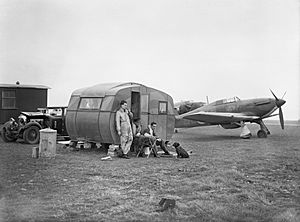Thomas Wallace (RAF officer) facts for kids
Quick facts for kids
Thomas Wallace
|
|
|---|---|
| Born | 5 October 1916 Johannesburg, Union of South Africa |
| Died | 11 November 1944 (aged 28) Dunkirk, France |
| Buried |
Pihen-Les Guines War Cemetery, France
|
| Allegiance | United Kingdom |
| Service/ |
Royal Air Force Royal Air Force Volunteer Reserve |
| Years of service | 1939–1940 (RAF) 1940–1944 (RAFVR) |
| Rank | Squadron Leader |
| Service number | 149635 |
| Commands held | No. 609 Squadron |
| Battles/wars | Second World War |
| Awards | Distinguished Flying Medal |
Thomas Young Wallace DFM (born October 5, 1916 – died November 11, 1944) was a brave South African fighter pilot. He was known as a flying ace for the Royal Air Force (RAF) during the Second World War. He shot down at least six enemy planes in air battles.
Thomas Wallace was from Johannesburg, South Africa. He joined the RAF in 1939. After finishing his training in 1940, he joined No. 610 Squadron. Later, he faced a problem with his service and had to leave the RAF. However, he quickly joined another part of the air force called the Royal Air Force Volunteer Reserve. He then flew with No. 111 Squadron in a Hawker Hurricane fighter plane. He achieved many victories during the famous Battle of Britain. For the next three years, he worked in roles that weren't about fighting. In September 1944, he became the leader of No. 609 Squadron. Sadly, he was killed in action while flying a Hawker Typhoon fighter over Dunkirk, France.
Contents
Early Life and Joining the RAF
Thomas Young Wallace was born in Johannesburg, South Africa, on October 5, 1916. His parents were William Francis and Ruth Agnes Wallace. In 1939, he left South Africa to join the Royal Air Force (RAF). He started his flight training in August at a school near Desford. Two months later, he was officially accepted into the RAF as a trainee pilot officer.
Serving in World War II
In November 1939, Wallace continued his flight training at Little Rissington. He finished his training in June 1940 and was sent to No. 610 Squadron. This squadron was based at Gravesend and flew Supermarine Spitfire fighter planes. Soon after he arrived, he went for a short training course at Uxbridge. During this time, he was away without permission for two days. Because of this, his time with the RAF ended on July 1. But Thomas Wallace quickly joined the Royal Air Force Volunteer Reserve (RAFVR) as a sergeant. Later in July, he joined No. 111 Squadron. This squadron flew Hawker Hurricane fighters from Croydon. They were training new pilots after fighting in France.
Fighting in the Battle of Britain
Soon after Wallace joined, No. 111 Squadron went back to active duty. They patrolled south-east England as the Battle of Britain became more intense. On August 15, Wallace shot down two Messerschmitt Bf 110 enemy planes. He also damaged two more. The next day, he destroyed a Messerschmitt Bf 109 fighter. He also likely shot down a Dornier Do 17 bomber. On August 18, he destroyed another Do 17 and damaged two others.
He damaged a Bf 109 on August 24. Two days later, he helped destroy a Do 17. On the last day of August, he shot down a Bf 110. He damaged a second one and likely destroyed another Do 17. On September 4, he shot down a Bf 109 and damaged three others. Three days later, Wallace's Hurricane plane was hit over the English Channel. But he managed to fly back to land before bailing out (parachuting to safety). His great success in these weeks earned him the Distinguished Flying Medal (DFM) in October.
The official award notice for his DFM said:
In a period of three weeks, Sergeant Wallace has destroyed seven enemy aircraft and probably another four. On one occasion he became separated from his squadron and, single-handed, pursued a formation of enemy bombers back to the French coast. While in mid-channel he was attacked by six enemy fighters, and although his aircraft was severely damaged in the resulting battle, he shot down one enemy aircraft and damaged another. Sergeant Wallace has displayed conspicuous courage and fighting ability.
—London Gazette, No. 34978, 25 October 1940.
By the time he received his DFM, No. 111 Squadron had moved to Scotland. They were given lighter duties after their intense fighting in the Battle of Britain.
Later War Service and Death
On November 3, Wallace helped damage a Heinkel He 111 bomber while flying east of Peterhead. This was his last aerial victory. After this, he moved to roles that were not about fighting. He was promoted to warrant officer. In March 1943, he became a pilot officer again. Six months later, he was promoted to flying officer.
In September 1944, Wallace was given command of No. 609 Squadron. This squadron flew Hawker Typhoon fighters in France. They were part of the Second Tactical Air Force. Their job was to attack German vehicles and support the Allied ground forces. These forces were moving into Belgium. Sadly, Wallace was killed by flak (anti-aircraft fire) on November 11, 1944. He was flying over Dunkirk at the time.
Thomas Wallace was buried at Pihen-les-Guines War Cemetery in France. He is officially credited with shooting down six enemy aircraft. He also shared in the destruction of one more. He likely destroyed two other planes and damaged ten, one of which was shared. Two of the planes he damaged were also listed as likely destroyed in his DFM award notice.
Images for kids



